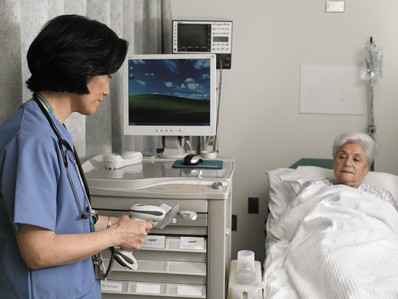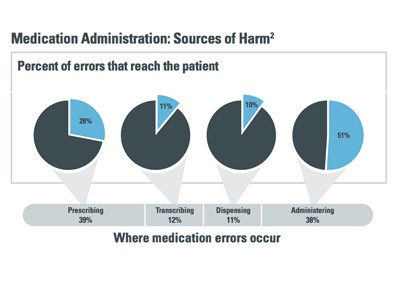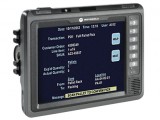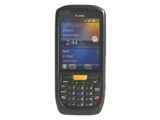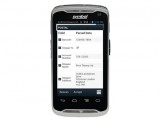Executive summary: a case for BPOC solutionsThe need for bar code point of care solutions is well documented. Medical errors are threatening patient safety and injecting costs into the industry that push the price of medical care higher every day — and all around the world, the errors are frighteningly common. A report by The Commonwealth Fund announced that one-fifth of the adults that were surveyed (or 22.8 million people) reported that they or a family member had experienced a medical error of some kind — with an estimated 8.1 million households experiencing a medical error that developed into a serious problem.
In addition, to comply with new government regulations designed to help improve the quality of care, healthcare organizations must create and maintain detailed electronic medical records (EMRs) for every patient to ensure that caregivers have the most complete and up-to-date information at the time of care. Compliance requires the entry of a wealth of information into the computerized records, including every medication and test order as well as all test results. And multiple checks and balances required for a wide variety of medical procedures further improve patient safety. For example, two forms of patient identification must be verified prior to medication administration.
BPOC solutions help healthcare providers address these issues by reducing the opportunity for errors and enabling compliance with government regulations — without inserting time-consuming steps into everyday processes that further pressure an already over-burdened staff. Caregivers can accurately collect, access and verify information electronically, anywhere and anytime, with either a mobile computer or bar code scanner. The process automation and the elimination of paper-based forms reduces cycle times and improves productivity, decision making and the quality of care. Consider the potential impact in medication administration alone, where 51 percent of the errors occur bedside during actual administration.
With such a strong case for BPOC solutions, you may be considering or may have already made the decision to deploy a BPOC solution. Regardless of whether you are evaluating feasibility or beginning the actual planning stage, there are four key aspects to consider, including:
- General pre-planning
- Wireless LAN (WLAN)
- Mobile device selection
- Post-deployment “PR”
In the following pages, you will find a discussion of each of these areas as well as checklists to help guide you through best practices for a highly successful BPOC solution that will better safeguard the health and lives of your patients.
General considerations
While there will be many matters to address during the planning stage, there are a number of core factors required to ensure a successful BPOC solution, from application selection to obtaining organization-wide support, justifying the investment and identifying any required related initiatives. The following checklist identifies some of the most important questions to answer as you begin the planning stages.
- Application selection: examine the 3 to 5 year goals of your facility
- Assess your IT capacity and expertise
- Bar code requirements
- Build awareness and obtain hospital-wide buy-in
- Develop and execute a change-management plan
- Identify and clearly communicate the benefits that justify the investment
- Determine if your solution is eligible for federal government subsidy
Wireless network technical considerationsYour wireless network is the backbone of your BPOC solution. A poorly deployed WLAN will lead to network access issues, which frustrate users and negatively impact the success of your initiative. In addition, BPOC solutions will test the limits of your WLAN, which must be able to provide a consistent anywhere and anytime connection experience, even though workers will roam through hallways to patient rooms, nurses stations, supply rooms, laboratories and more. The following checklist will help you design a future-proof WLAN that will provide the dependable real-time network access required to accommodate all users and applications - today and tomorrow.
- Reach
- Reliability
- Regulatory-ready security
- Scalability
Mobile device technical considerations
You can enable bar code point of care with: handheld mobile computing devices which can provide voice, data access and bar code scanning; with workstations on wheels (COWs/WOWs); or with tablet PCs. While cost considerations will be a large factor in device selection, the following list of strategic and technical considerations can help you identify device criteria to ensure you select the best devices for each application.
- Distribution
- Durability
- Ergonomics
- Readability
- Voice functionality
- Data capabilities
- Wireless connectivity
- Processing power / memory
- Battery life
- Device management
- Support services
Choosing a vendor for your BPOC solution
What are the top four criteria healthcare organizations factor into vendor selection?
1. A broad portfolio. A diverse portfolio minimizes the number of vendors that are required, reducing complexity from planning through deployment. When components can be sourced through a single vendor, you’ll enjoy the simplicity of a single source of contact, despite the types of mobile devices you need, or whether you need wireless switches, access points and management packages. Integration will be simplified and your solution will be launched faster, with less business disruption — and risk.
2. Industry expertise. The richer your vendor’s industry experience, the more insight and value they can provide. With intimate knowledge of your pain points, the best practices others are utilizing to address those pain points, changing government regulations and the challenges associated with compliance, a vendor is able to provide solid strategic direction to help you launch highly successful BPOC solutions.
3. Responsive. Your environment is mission critical. You need a vendor that can consistently provide the appropriate level of attention and response required during every phase of your BPOC initiative — from the design quality of your wireless network to technical support.
4. Longevity. BPOC solutions become an integral part of your hospital operations. To ensure robust support, the vendor you choose should demonstrate ‘staying power’ for many years into the future.
Post-deployment “PR”: internal and external
Once your BPOC solution has been deployed long enough for you to substantiate its success with hard metrics, promoting your BPOC solution to hospital employees and the public is the final step in maximizing benefits.
Internal PR
Communications to internal employees can reflect actual reduction rates in errors as well as productivity gains and how they enable better patient care. For example, nurses gaining an hour a day have more time to focus on patient care. Ensuring that your employees see the value of your BPOC solution helps maintain and increase adoption rates, as well as paves the way for a positive attitude toward future BPOC solutions.
External PR
Public communications can help attract new patients as well as new healthcare workers. Note that the messaging in externally focused public relations efforts may often be very different than internal audiences due to the sensitive nature of certain information. For example, where you might tout a 99 percent reduction in medication errors to your hospital staff, you would likely not want to release that statistic publicly, lest it inadvertently project the image that a stay at your hospital was previously hazardous. Instead, the messages should be focused on a higher-quality, error-free environment.
The benefits of BPOC solutions
BPOC solutions provide strong benefits for healthcare providers. When a world leader in healthcare known for innovative medicine, advanced technology and compassionate care implemented a pilot to test the value of a handheld computer at patient bedside, results included:
- A 60% reduction in time required to document vital signs, allowing each clinician to recover 30 minutes per 8 hour shift.
- Clinical data latency — the cycle time between when vital sign data was captured and when it was entered into the EMR — was reduced by over two hours.
- An 83% reduction in the number of data items that had to be manually captured and entered into the computer dramatically reduced the potential for transcription error.
Why Zebra
Every day, organizations of all sizes all over the world count on Zebra mobility solutions to maximize personnel effectiveness, improve services, and increase revenue potential. When you choose Zebra for your mobility solution, you get the peace of mind that comes with choosing an industry leader as your technology partner. Zebra offers the proven expertise and technology you need to achieve maximum value and a fast return on investment—as well as first hand experience in virtually every size organization in nearly every major industry. And our end-to-end solutions offer the simplicity of a single accountable source—regardless of the number of vendors involved.
Our comprehensive product offering includes: rugged and enterprise class mobile computers with extensive advanced data capture and wireless communications options; rugged two-way radios for always on voice communications; private wide area and local area wireless network infrastructure enables robust real-time wireless connectivity indoors and outdoors in a campus-style facility — as well as between multiple location; comprehensive RFID infrastructure, including fixed, mobile and handheld RFID readers; a partner channel delivering best-in class applications; software solutions that enable centralized and remote management of every aspect of your mobility solution; and a complete range of pre-and post-deployment services to help get and keep your mobility solution up and running at peak performance every day of the year.

















